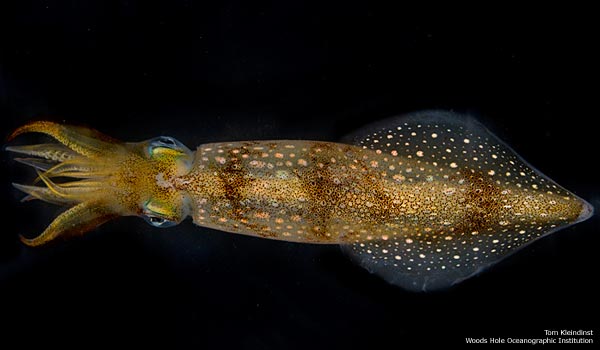How Squid Hear: It's All in the Motion of the Ocean

Squid can hear, scientists have confirmed. But they don't detect the changes in pressure associated with sound waves, like we do. They have another, more primitive, technique for listening: They sense the motion generated by sound waves.
"They are detecting themselves moving back and forth with the sound wave," said T. Aran Mooney, a marine biologist at the Woods Hole Oceanographic Institution in Massachusetts. He compared a squid in the ocean being jostled by a sound wave to a piece of fruit suspended in Jell-O. "If you jiggle the Jell-O, the whole block of Jell-O is moving with the fruit."
In a study published in October in the The Journal of Experimental Biology, Mooney and his colleagues confirmed that longfin squid (Loligo pealeii), which are also a popular seafood meal, can indeed detect sound at low frequencies. Now, the researchers are working to better understand how this hearing mechanism works.
"The idea is maybe if these guys do have a primitive sense of hearing can we use them as a model to understand the foundation of hearing or how hearing is lost," he said. This research may ultimately be applicable to humans.
Squid have two sac-like organs called statocysts near the base of their brains. Hair cells line the sac and project into it, while a tiny grain of calcium carbonate, called a statolith, resides inside the sac. When the squid moves, the hair cells rub against the statolith, bending the hair cells inside the sac. This generates electrical signals that get sent to the animal's brain telling the squid it has detected a sound.
In humans, the part of the inner ear responsible for converting vibrations into electrical signals that travel to the brain, called the cochlea, also relies on hair cells.
In fact, Mooney's team used the same technique to test squid hearing as is used for people, although the squid had to be anesthetized with magnesium chloride to keep them still. Using underwater speakers intended for synchronized swimming, the scientists played sounds in a tank, while using sensors to measure nerve responses in the squid.
Sign up for the Live Science daily newsletter now
Get the world’s most fascinating discoveries delivered straight to your inbox.
Their results showed that squid can only listen in at low frequencies of up to 500 hertz. (By comparison, humans hear frequencies from about 20 to 20,000 hertz.) This means squid can probably detect wind, waves and reef sounds, but not the high-frequency sounds emitted by the dolphins and toothed whales that eat them, Mooney said.
- Dangers in the Deep: 10 Scariest Sea Creatures
- Our 10 Favorite Monsters
- 10 Amazing Things You Didn't Know About Animals
You can follow LiveScience writer Wynne Parry on Twitter @Wynne_Parry.










